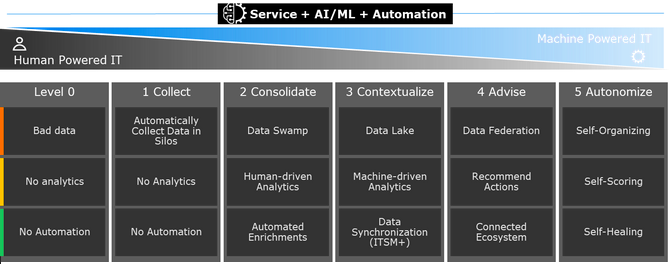In the ScienceLogic webinar, “Clearing the Path for Automated Operations,” we look at how one global technology organization got their IT house in order through the application of AIOps and a strategic approach to implementation, based on ScienceLogic’s AIOps Maturity.

ITOps teams are overloaded with manual, repetitive work that creates management bottlenecks and takes time away from new projects. Legacy IT operations tools and processes were not made for today’s massive, complex infrastructures, and the inefficiencies associated with continuing to work with yesterday’s tools are holding businesses back. That’s why there’s high interest—and demand—for IT operations automation through AIOps.
IT automation is not just about speed, efficiency, and cost reduction—it’s about survival. And AIOps is revolutionizing how IT operations teams can minimize human interaction and human analytics in their IT processes, to evolve to a more automated state of operations that drives desired business outcomes. It’s a shift from human-powered to machine-powered IT.
Prepare Yourself for AIOps
According to Gartner, 30% of enterprises will rely on AIOps to drive their businesses decisions within the next three years. Unfortunately, many organizations will embark on the journey to AIOps unprepared for what it takes to achieve a fully automated enterprise. That is why ScienceLogic introduced its AIOps maturity model in response to what we’ve experienced with customers that have successfully navigated the path to machine powered IT by progressing along three dimensions of AIOps:
- Data
- Analytics
- Automation
The goal of AIOps-driven automation is to relieve people from the responsibility of tedious, time-consuming tasks and human analysis. That allows your team to achieve autonomous operations, more efficiently allocate both your people and the IT resources they manage and focus on higher-level tasks that deliver a better customer experience, including innovating around business services.
As appealing as that goal is, most organizations haven’t moved past levels one or two. What we’ve observed is that these organizations are not yet prepared for the full measure of doing what it takes to achieve AIOps-driven automation. Some initially thought IT automation would be easy to achieve by merely investing in new technology. What we try to impress upon our customers from the outset is that the AIOps journey is just that – a journey. And journeys are not simple. No matter where you are in your journey, and even if you are stuck along the path with the wrong partner, it’s going to take work and the right tools to get you there. But the results are well worth the investment.
Grappling with IT Chaos
Capgemini is a €16 billion company of 270,000 people in nearly 50 different countries. Capgemini maintains 22 data centers around the world with an IT estate that consists of over 400 corporate applications, over 300 thousand network endpoints, and a half-million networked assets spread out over 350 physical offices.
But that IT estate was not designed and built from a blank slate. It evolved over time from both organic growth and through acquisition. When ScienceLogic started working with Capgemini, we identified several operational challenges associated with the configuration of a network that was being managed with a lot of inherited, legacy tooling. The result was IT monitoring siloes and visibility gaps. In fact, before they started working with ScienceLogic, Capgemini estimated they only had 30% discovery and monitoring of their infrastructure, and more concerning, they lacked context from which to evaluate the health, availability, and reliability of the critical business services they were delivering to their employees.
Worse, that 30% of monitored infrastructure was generating more than 50,000 incidents per year, while suffering 40-45 major service outages each month. Their lack of visibility and context meant the IT operations team was unable to understand the nature of incidents quickly and efficiently, or triage response. As a result, mean time to repair (MTTR) was high. In fact, their slow, reactive posture often resulted in customers notifying them of outages before their own monitoring tools.
Bringing Clarity to the Chaos
ScienceLogic engaged with Capgemini to help them assess their situation and understand, through a series of ScienceLogic Clarity Workshops, how AIOps could help them gain control over their infrastructure, achieve complete visibility of their IT estate, and start down the path of realizing the AIOps maturity model to transform their IT operations.
Jonathan Chivers, Senior Director of Global Solutions at ScienceLogic, had a front-row seat for Capgemini’s journey to automation through AIOps. In this webinar he describes how Capgemini and ScienceLogic worked together collaboratively to develop their digital transformation strategy, in incremental steps, to achieve their desired outcomes.
When ScienceLogic first engaged with Capgemini, they were stuck on level one of the AIOps maturity model. They were doing data collection, but with 70% of their infrastructure unmonitored, they had an incomplete, inaccurate configuration management database (CMDB), and no way to conduct meaningful analytics. To make progress, they had to take four big steps:
- Improve visibility from 30% to 100% by adopting a single platform for monitoring across the entire estate
- Shift to a posture of service health monitoring (vs device monitoring)
- Establish measurable goals for improving MTTR
- Shift from reactive IT ops to proactive monitoring using AI/ML.
Some of their measurable goals included taking short-term action to reduce service outages by 75%, reduce the volume of major incidents by 50%, reduce the average time to resolve incidents by 35%, and populate and maintain a complete and accurate CMDB in real-time. These were modest and achievable goals that fit within the ScienceLogic “crawl, walk, run” philosophy that is predicated on building momentum and enthusiasm by tackling small but vital tasks and showing what’s possible.
Transformative Momentum
Over the course of several months, and with the ScienceLogic SL1 platform as the foundation for transformation, Capgemini was able to achieve these goals, and quickly progress from merely collecting data from a portion of their estate, to achieving 100% discovery and monitoring coverage—which turned out to be a sevenfold increase in the number of devices being monitored. But that meant Capgemini had a clear picture of its infrastructure, and confidence in the accuracy of the data it was collecting and using to update its CMDB, and for showing context for meaningful analytics. That put Capgemini in position to move beyond data collection, tackle analytics, and begin to implement IT operations process automation.
Today, with the help of SL1, Capgemini has completely transformed its own IT estate, improved the efficiency and reliability of its services, and enabled more customer-centric service delivery. And it is using its own journey to AIOps-enabled automation to help its customers do the same.
For the complete story of “Clearing the Path for Automated Operations,” watch the entire webinar. And if you’re interested in how ScienceLogic can help you on your own path to automated operations, get in touch and have a conversation with one of our experts.
 See ScienceLogic in actionTake a Tour
See ScienceLogic in actionTake a Tour Take Skylar One for a SpinStart Your Test Drive
Take Skylar One for a SpinStart Your Test Drive The Gartner® Magic Quadrant™ for Observability PlatformsRead the Report
The Gartner® Magic Quadrant™ for Observability PlatformsRead the Report The Forrester Wave™: AIOps Platforms, Q2 2025Access the Report
The Forrester Wave™: AIOps Platforms, Q2 2025Access the Report Future-Ready IT: Secure Migration, Faster Value, and Smarter OperationsWatch Now
Future-Ready IT: Secure Migration, Faster Value, and Smarter OperationsWatch Now

